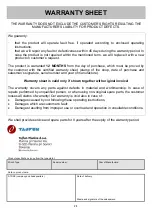
9
4.2. PULLING ( COILING THE WIRE ROPE ) (Figure 4 )
By pulling the
black
string
11
, pull the clutch handle
10
and the winch begins to pull.
Always pull the clutch handle to the far end of the groove
H
.
Proceed as described to prevent clutch plates from slipping to increase clutch life time.
The pulling is stopped
when you quickly release the clutch string
11
and clutch handle
10
returns to the right position.
During the pulling, the brake handle
20
is blocked in the right position. If the “permanent
brake release” (brake handle
20
was blocked in the left position) has been engaged, the
brake handle
20
automatically switches to the right position, when you pull the clutch
handle
10
. In this position the brake prevents the load from sliding backwards when the
pulling is stopped.
WARNING
:
If the brake handle
20
has been previously in the left “permanent brake release” position, the
brake handle
20
may suddenly switch back to the right position, when you move the clutch
handle
10.
Although the power of the PTO shaft drive remains constant, the pulling power changes.
It is useful to know that at the constant drive power, the pulling power depends on the length
of the wire rope coiled to the drum. The strongest pulling power is achieved at the first layer of
coils. By multilayer coiling the pulling power decreases progressively. The pulling power
changes in inverse proportion to the pulling speed, which is highest when the wire rope if fully
coiled.
The nominal pulling
is the highest power achieved by the winch with the first layer of coils on
the drum. It is defined in the technical data section of this operating instructions and on the
type plate of each winch. By increasing the number of coil layers on the drum, the pulling
power decreases. With the full drum the pulling power comes to 50 % to 60 % of the nominal
pulling power.
Содержание EGV 45A
Страница 14: ...14 8 33 H 11 10 31 30 F 45 A 270 N 55 A 270 N 65 A 220 N 85 A 260 N...
Страница 22: ...22...
Страница 23: ...23...






























